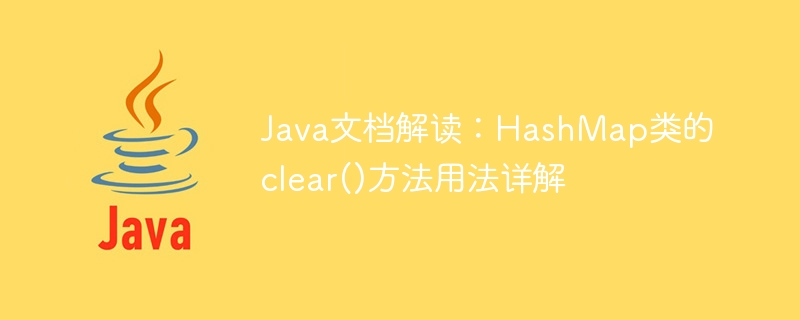Home >Java >javaTutorial >Interpretation of Java documentation: Detailed explanation of the usage of clear() method of HashMap class
Interpretation of Java documentation: Detailed explanation of the usage of clear() method of HashMap class
- 王林Original
- 2023-11-04 14:19:52878browse

Java Document Interpretation: Detailed Usage of the clear() method of the HashMap class
HashMap is one of the commonly used data structures in the Java collection framework, used to store key-value pairs . The clear() method is a method in the HashMap class, used to clear all key-value pairs in the HashMap. This article will explain the usage of HashMap's clear() method in detail and provide specific code examples.
1. Method introduction
In the HashMap class, the clear() method is declared as follows:
public void clear()
clear() method There are no parameters, and the return value type is void, because it is only used to clear the key-value pairs in the HashMap without returning any results.
2. Method Implementation
The implementation of the clear() method is very simple. It only needs to set the table array in the HashMap to null to clear all key-value pairs in the HashMap. The specific code is as follows:
public void clear() {
modCount++;
Entry[] tab = table;
for (int i = 0; i < tab.length; i++)
tab[i] = null;
size = 0;}
In the code, modCount is used to record the number of times the HashMap structure has changed, Entry[] tab It is an array inside HashMap, used to store key-value pairs. By looping and setting each element in the array to null and setting size to 0, all key-value pairs in the HashMap can be cleared.
It is worth noting that the clear() method does not release the memory space occupied by HashMap, but only sets the references of all key-value pairs to null. If you want to release the memory occupied by HashMap, you can set the HashMap instance to null, so that the Java garbage collector can reclaim the memory occupied by the object at the appropriate time.
3. Usage Example
The following is a sample code that uses the clear() method to clear a HashMap:
import java.util.HashMap;
public class HashMapExample {
public static void main(String[] args) {
HashMap<String, Integer> hashMap = new HashMap<>();
hashMap.put("A", 1);
hashMap.put("B", 2);
hashMap.put("C", 3);
hashMap.put("D", 4);
System.out.println("HashMap中的键值对数量:" + hashMap.size());
hashMap.clear();
System.out.println("调用clear()方法后,HashMap中的键值对数量:" + hashMap.size());
}}
Run the above code, the output result is:
The number of key-value pairs in HashMap: 4
After calling the clear() method, Number of key-value pairs in HashMap: 0
As can be seen from the results, all key-value pairs in the HashMap are successfully cleared using the clear() method.
Summary
The clear() method of the HashMap class is a simple and commonly used method. By calling this method, you can efficiently clear all key-value pairs in the HashMap. In actual applications, when you need to clear a HashMap, you can choose to use the clear() method to perform the operation.
The above is the detailed content of Interpretation of Java documentation: Detailed explanation of the usage of clear() method of HashMap class. For more information, please follow other related articles on the PHP Chinese website!

